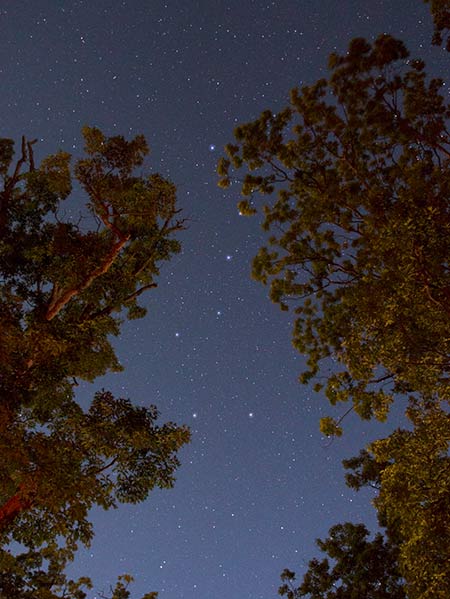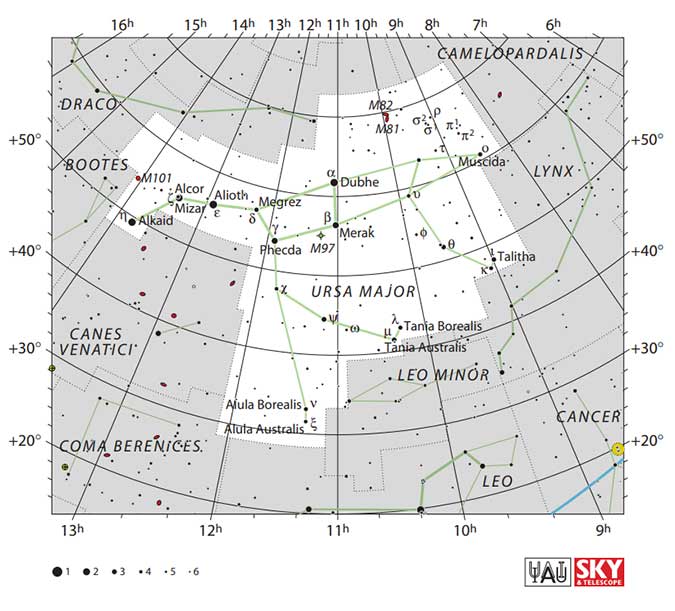The Ursa Major Constellation
Ursa Major, also known as the Great Bear, is the largest constellation in the northern hemisphere’s sky. It is the third-largest out of the 88 constellations in the sky.
The name is Latin meaning greater she-bear. Ursa Major is known as the greater (or larger) bear when compared to nearby Ursa Minor, also known as the lesser bear.
Ursa Major is one of the original 48 constellations listed by Ptolemy in the second century CE. The brightest stars in this constellation form the Big Dipper asterism, also known as the Plough. This particular asterism is one of the most recognizable shapes in the sky.
The flag of Alaska contains the image of the Big Dipper along with the Polaris star.
The Big Dipper asterism in Ursa Major.
Ursa Major Constellation Details:
- Symbolism: The Great Bear
- Brightest star: Alioth
- Number of stars (Total): 135
- Size: 1280 sq. deg. (3rd largest)
- Right Ascension: 10.67h
- Declination: +55.38°
Ursa Major’s Prominent Stars
Ursa Major contains a number of prominent stars. The constellation is primarily known from the asterism which is formed by the constellations seven main stars.
Big Dipper Stars:
- Alkaid
- Mizar
- Alioth
- Megrez
- Phecda
- Merak
- Dubhe
Although this part of the constellation represents the Great Bear’s hind legs and tail, these bright stars form the popping image of a ladle. This asterism has two bright stars that can be used as a navigational pointer. These two stars are Dubhe and Merak. They point to the location of the current northern pole star, Polaris.
Polaris is the north star that is located in the Ursa Minor constellation. Dubhe is also referred to as Alpha Ursae Majoris. Dubhe is an orange giant star around 120 light-years from Earth. It is the second brightest star in the constellation with a magnitude of 1.79.
Dubhe is the 35th brightest star in the sky. Merak is also known as Ursae Majoris. It is a white star with a magnitude of 2.37. That is around three times the mass and radius of our sun.
Merak also has surface temperatures that are roughly twice as hot as our sun.
The Alkaid star, or also called Eta Ursae Majoris, is the tip of the Great Bear’s tail. Or also seen as the tip of the Big Dipper’s handle. It is a bluish-white star. It has a magnitude of 1.85 and surface temperatures around 3 times hotter than our sun. Alkaid is the third brightest star of Ursa Major.
The second star from the end of the tail or handle is Mizar-Alcor or known as Zeta Ursae Majoris. It is the constellation’s fourth-brightest star. Mizar forms a famous double star, with its companion Alcor. The Arabs termed these two stars as the horse and rider. Among them, the ability to see these two stars with the naked eye was often considered a test of good eyesight.
The third star is Alioth, or also referred to as Epsilon Ursae Majoris. Alioth is the brightest star in the Ursa Major constellation. It is the 33rd brightest star in the sky, consisting of magnitude 1.76. It has a distance of around 80 light-years from Earth.
The Big Dipper as seen from my Bortle Scale Class 8 backyard.
The fourth star is Megrez or Delta Ursae Majoris. Megrez is located at the intersection of the body and tail of the bear or the ladle and handle of the dipper. It is a white star and is around 60 light-years from Earth.
After Megrez we have the star Dubhe, completing the top frame of the dipper. Merak is the star that outlines the bottom of the dipper. Phecda or also known as Gamma Ursae Majoris completes the bottom frame of the dipper. Phecda is a white star with a magnitude of 2.44.
Muscida is the star that is located at the head of the bear. This star is also known as Omicron Ursae Majoris. It is a yellow giant star with a distance of around 180 light-years from earth.
Talitha is the star located at the bear’s front legs. It is referred to as Lota Ursae Majoris. This star is a four-star system. It contains two pairs of binary stars that are roughly 45 light-years away from earth.
The remaining stars are located in the bear’s hind legs. These stars are known as the Tania Borealis, Tania Australis, Alula Borealis, and Alula Australis.
Tania Borealis is a white star that is about 140 light-years from the earth. Tania Australis is a red giant star around 240 light-years from earth.
The Alula Borealis is an orange giant with a distance of around 400 light-years from earth. Alula Australis is a four-star system. It consists of two pairs of binary stars. These stars are 30 light-years from our earth. The main stars in this system are like sun stars. The other ones are considered to be red dwarfs.
Deep-Sky Objects in Ursa Major
Ursa Major contains seven Messier objects that are located within and around the constellation. The most famous of these seven are the Pinwheel Galaxy, Bode’s Galaxy, the Cigar Galaxy, and the Owl Nebula.
The other three Messier objects are referred to as Messier 40 (M40, Winnecke 4), Messier 108 (M108, NGC 3556), and Messier 109 (M109, NGC 3992).
The Ursa Major constellation also contains 13 stars within it that are confirmed as planets. There are two meteor showers associated with the constellation; the Alpha Ursa Majorids and the Leonids-Ursids.
Ursa Major constellation belongs to the Ursa Major family of constellations. This family of constellations consists of Boötes, Camelopardalis, Canes Venatici, Coma Berenices, Corona Borealis, Draco, Leo Minor, Lynx, and Ursa Minor.
M81, M82, and NGC 3077 can be seen in this photo (view larger version).
M101, The Pinwheel Galaxy lies near the handle of the Big Dipper in Ursa Major.
Location in the Night Sky
Ursa Major is the third largest constellation in the sky. It occupies an area of 1,280 square degrees.
Ursa Major is located in the second quadrant of the northern hemisphere. It can be seen at latitudes between +90° and -30°. The best time to see this constellation is in the spring. At this time Ursa Major is high above the north-eastern horizon.
The eight neighboring constellations to the Great Bear are Draco to the north and northeast. Boötes to the east. Canes Venatici to the east and southeast. Coma Berenices to the southeast.
Leo and Leo Minor to the south. Lynx to the southwest and Camelopardalis to the northwest. From southern temperate latitudes, the Big Dipper is unable to be seen. However, some of the southern parts of the constellation can be seen.
Ursa Major constellation map from the IAU and Sky & Telescope magazine.
Origin of the Great Bear
The Great Bear is one of the oldest constellations in the night sky. It can be dated back up to 13,000 years. It is mentioned in the Bible and also found in the works of the Greek author, Homer.
In Greek mythology, the constellation is associated with the myth of Callisto. Callisto was the beautiful nymph who had sworn a vow of chastity to the goddess Artemis. One day Zeus saw the nymph and the two fell in love.
Artemis banished Callisto when she discovered that Callisto’s vow was broken. Zeus and Callisto had a son named Arcas.
However, it was Hera, a jealous wife of Zeus who turned Callisto into a bear.
Callisto lived as a bear for 15 years, until she came face to face with her son Arcas. Arcas quickly drew his spear but before he could attack Zeus intervened to prevent disaster. Zeus sent a whirlwind that lifted Callisto and Arcas into the heavens. Arcas became the constellation Boötes, or also known as the Herdsman. Callisto became Ursa Major.
Among the Greek myths there are different versions of this tale. Another asserts that it is Artemis who transforms Callisto into a bear as punishment for breaking her vow of chastity. Many years later, Callisto along with Arcas become captured in a forest.
They are imprisoned and taken to King Lycaon as a gift. However, the mother and son are able to escape and take refuge in the temple of Zeus. Not realizing that their trespassing is punishable by death, Zeus comes and intervenes to save them by placing them both in the sky.
The Ursa Major constellation is associated with several Greek and Roman myths. The Romans called the constellation Septentrio, or seven plough oxen.
However, only two of the seven stars represented the oxen, while the others formed a wagon.
In Hindu legend, the brightest stars represent the Seven Sages. The Hindus termed the constellation as Saptarshi. The sages are Bhrigu, Atri, Angirasa, Vasishta, Pulastya, Pulalaha and Kratu.
The ancient Chinese believed the seven bright stars represented Tseih Sing, the Government, or Pih Tow, the Northern Measure. In South Korea, the constellation is referred to as the Seven Stars of the North.
In some Native American stories, the three stars in the asterism’s handle of the dipper represented three warriors chasing a great bear. In recent American history, the Big Dipper was used in the Underground Railroad.
Its’ position in the sky helped slaves find their way north. Numerous songs spread among slaves in the south encouraging them to follow the ‘Drinking Gourd’ to find a better life.

This is the star around which the whole northern celestial sphere appears to turn throughout the night. This is because Polaris is located nearly above Earth’s northern axis.
Helpful Resources:
The following video will provide you with an excellent overview of the constellation Ursa Major. The host covers several interesting facts about the constellation as a whole, and the Big Dipper asterism within it.







